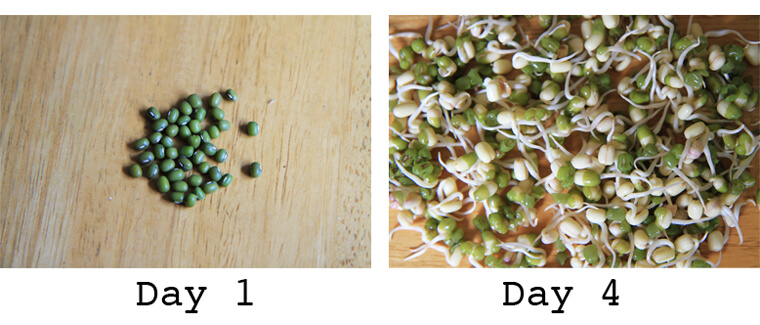When we think of sprouting, most people think of alfalfa sprouts. What most people don’t realize is that you can sprout any truly raw seed, nut and/or grain or legume. You don’t have to be a health nut (no pun intended) or a raw foodist to be a sprouter. I began my adventures in sprouting this spring and it has turned into a real obsession in our house. I’ve sprouted chickpeas, lentils, mung beans and alfalfa so far. We can’t get enough of them.
Sprouts are a miracle food. Sprouts can be grown any time of the year, without soil, maturing in three to five days even without sunshine and rival almost any food in nutrition value. Sprouts will grow year-round in any climate with very little effort to provide vital, organic, locally grown produce (as local as your own kitchen!).
Sprouts are seeds, nuts, beans, or gains that have been germinated with water. This initiates the growth process. Sprouting transforms seeds from a dry, dormant storehouse of nutrition into a wealth of bioavailable vitamins, minerals, and protein that is rich in enzymes for easy digestion. Sprouts are abundant in all essential amino acids (the building blocks of protein), vitamins, minerals, chlorophyll, and enzymes. Sprouts are perhaps the most vital of all fresh foods. Sprouting actually increases the nutritional value of foods. A seed contains more concentrated nutrition that the plant on which it grew. As a plant matures, energy is collected and focused into producing a seed for reproduction. The seed is the storehouse of essential energy. When the seed is germinated, the potential energy is awakened and the complex concentration of energy is broken down into a simpler, more available state. which is easier to digest.

Sprouts are nutritional powerhouses. Any means of incorporating and munching sprouts on a regular basis is a champion of choices. They can be put into salads, breads, used in soup… or eatten as is.
Equipment for sprouting:
- Glass jar with a wide mouth
- 1 piece of screen or mesh
- 1 rubber band (to secure the screen or mesh)
- Fresh water
- Seed, nut, bean, or grain of choice
How to make sprouts
Use one part seed to at least three parts water. Soak in a wide-mouth jar. All measurements below yield one quart of ready sprouts. Half-gallon or larger jars are more convenient.
Seed Soak time Days to sprout
2 Tbsp. alfalfa 6 hours 5-6 days
½ cup lentils 8 hours 3 days
½ cup mung beans 8 hours 3-5 days
1 cup wheat or rye 12 hours 3 days
1 cup garbanzo beans 12 hours 3-5 days
2 cups sunflower seeds 12 hours 2 days
Directions:
- Cover the mouth of the jar with a plastic or stainless steel sprouting screen or cheesecloth, which is tied on or secured with a rubber band (I use a sprouting jar). After soaking seeds, drain well and keep in a warm dark place.
- Rinse twice a day, ideally morning and evening. Keep jar tilted mouth down for better drainage.
- After a few days you will notice nice little sprouts appearing. Once ready, they can be refrigerated. They keep up to one week in a plastic bag or covered glass jar.





Pingback: Dinner Menu: August Week 2 | Jodiann's Sky Pie()
Pingback: 10 Homemade Versions of Everyday Plant-Based Kitchen Staples | Vegan Runner Eats()